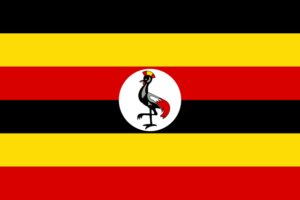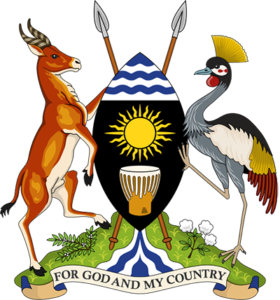The Republic of Uganda is a landlocked country bordered by Kenya in the east, Sudan in the north, Democratic Republic of the Congo in the west, Rwanda in the southwest and Tanzania in the south.
Uganda takes its name from the Buganda kingdom, which encompassed a portion of the south of the country including the capital Kampala.
Uganda’s total land area is 241,559 sq km. About 37,000 sq km of this area is occupied by open water while the rest is land. The southern part of the country includes a substantial portion of Lake Victoria, which it shares with Kenya and Tanzania.
Uganda is located on the East African plateau, averaging about 1,100 meters (3,609 ft) above sea level. The plateau generally slopes downwards towards Sudan explaining the northerly tendency of most river flows in the country. Although generally equatorial, the climate is not uniform since the altitude modifies the climate.
Uganda’s elevation, soil types and predominantly warm and wet climate impart a huge agricultural potential to the country. They also explain the country’s large variety of forests, grasslands and wildlife reserves. Uganda has a total population of about 32 million people.
The People of Uganda
Over 80 per cent of the population live in rural areas and directly survive off the environment and natural resource base.
Population: Uganda’s population has continued to grow rapidly over time. It increased from 9.5 million in 1969 to 24.2 million in 2002. Between 1991 and 2002, the population growth rate was 3.2 percent. The population is projected to have increased to 32.9 million by mid-2011
Ethnic groups: Baganda, Banyankole, Bakiga, Bunyoro, Batoro, Langi, Acholi, Lugbara, Karamojong, Basoga, Bagisu, Ateso, Bagwere, Kumam, Alur, Basamia-Bagwe, Banyole, Baruuli-Banyara, Batwa, Bafumbira, Lugbara, Japadhola, Kakwa and others. The Baganda are the largest ethnic group in Uganda and comprise approximately 17% of the population.
Religions: Christian, Muslim, Indigenous Beliefs and others
Languages: English (official), Swahili (official), Luganda, and numerous other local languages.
Uganda’s Climate
Uganda’s weather conditions are ideal, ranging from the warmth of the lowland areas to the coolness of the highlands in the South West Kigezi.
For most of the year, Uganda is sunny with temperatures rarely rising above 29 degrees. The average temperature is about 26 degrees C, with a maximum of 18-31 degrees and minimum of 15-23 degrees depending on the part of the country.
The rain season is March-May. Light rain season is November and December. Wet seasons are March –May and October-November; dry seasons are December to February and June to August.
Rainfall ranges between 500mm to 2500 mm and the relative humidity is 70 – 100%. The rainfall regime allows two planting and harvesting seasons a year in most parts of the country, without the use of irrigation.
About 34% of the country is covered in wetlands with a dense network of rivers, lakes and swamps.
Generally, the country is endowed with fertile soils. Uganda has some of the largest lakes on the continent including Lake Albert and Lake Victoria
The Government
Type: Republic.
Constitution: it was ratified in July 12, 1995 and promulgated October 8, 1995.
Branches: Executive–president, vice president, prime minister, cabinet. Legislative–parliament. Judicial–Magistrates’ Courts, High Court, Court of Appeals (Constitutional Court), Supreme Court.
Political parties: 38 registered parties. Major political parties include the National Resistance Movement (NRM, the ruling party), Forum for a Democratic Change (FDC), Democratic Party (DP), Conservative Party (CP), Justice Forum (JEEMA), and Uganda People’s Congress (UPC), among others.
National holiday: Independence Day, October 9.
The 1995 Constitution established Uganda as a republic with executive, legislative, and judicial branches. The constitution provides for an executive president, to be elected every 5 years. President Yoweri Museveni, in power since 1986, was elected in 1996 and reelected in 2001, 2006, and 2011. Legislative responsibility is vested in the parliament; legislative elections are held every 5 years. Because of redistricting, the parliament elected in February 2011 grew from 332 to 375 members, including 112 special seats for women, 10 special seats for military, five for youth, and five for persons with disabilities. The Ugandan judiciary operates as an independent branch of government and consists of the Magistrates Court, the High Court, the Court of Appeal (which also sits as the Constitutional Court when required) and the Supreme Court.
Foreign Relations
The Ugandan Government generally seeks good relations with other nations without reference to ideological orientation. Uganda’s relations with Rwanda,D.R.C. and Sudan have sometimes been strained because of security concerns. Uganda, D.R.C., Rwanda, and Burundi participated in the U.S.-facilitated Tripartite Plus process, which helped ease tensions and contributed to increased bilateral contacts with the aim of resolving conflicts between the neighbors. Uganda has over 4,000 peacekeepers in Somalia as part of the African Union Mission in Somalia (AMISOM).
Bilateral relations between the United States and Uganda have been good since Museveni assumed power, and the United States welcomed Museveni’s efforts to end human rights abuses and to pursue economic reform.
Uganda is a member of the UN, the Commonwealth of States, and several related agencies, and is a founding member of the Organization of African Unity (OAU). It also belongs to the Non-aligned Movement, the Group of 77, and the Organization of the Islamic Conference. Uganda welcomes diplomatic relations with all nations, regardless of ideology.
Uganda is a member of the World Trade Organistion (WTO), COMESA, East African Community (EAC)
Tourism in Uganda
Wondering why it is called ‘The Pearl of Africa‘? Where else can you see lions prowling across the open savanna as day breaks before white water rafting down the Nile; then the next day set off into the misty mountains in search of the majestic mountain gorillas before settling in to watch a local cultural evening around the camp fire?
Uganda has been ranked the number one destination for tourists for the year 2012 by Lonely Planet which is the largest travel guide and media publisher in the world.
The following week, Qatar Airways, a member of the five star alliance, announced that it would be launching a service to Uganda’s international hub, Entebbe Airport.
Uganda Tourism Board
Uganda Tourism Board has served the country in ensuring the success and growth of tourism in Uganda for over 15 years. This has been in conjunction with the Ministry of Tourism, Trade and Industry since its inception. The world over, the board is marketing and promoting the Pearl of Africa, its true nature, culture, wildlife, accommodation, and hospitality all packed in a country that is “Gifted by Nature”.
More about tourism visit: www.visituganda.com
The Flag and the meaning
From the top, a total of six horizontal stripes of black, yellow, red, black, yellow, red.
Black symbolises our African heritage and Uganda’s fertile soil. Yellow is for the glorious sunny days, so characteristic of Uganda. Red symbolises the red blood that runs in our veins, forming a common bond to all humankind.
The majestic crested crane (Regulorum gibbericeps) is Uganda’s National Bird.
Coat of Arm
The Uganda motto is “For God and My Country“
Standing on a green mound is a shield and two crossed spears. The green symbolizes Uganda’s lush, green vegetation.
Supporting the shield are the Uganda Kob (Adenota kob Thomasi), symbolizing abundance of wildlife; and the Crested Crane (Regulorum gibbericeps), Uganda’s national bird.
The shield and spears symbolize our readiness to defend our motherland against all enemies. Across the top of the shield are the waves of Lake Victoria, the second largest fresh water lake on earth.
In the centre of the shield is the sun, representing Uganda’s glorious sunny days. At the bottom of the shield is the traditional African drum, used for dancing, ceremonial rituals, and for summoning the people to rally.
Coffee and cotton, Uganda’s main cash crops, are displayed on the green mound; together with the River Nile, the world’s longest river; which starts its 8 000 km (5 000 mile) journey in Uganda.
The Uganda National Anthem.
Oh Uganda may God uphold thee, We lay our future in thy hand, United free for liberty Together we'll always stand. Oh Uganda the land of freedom, Our love and labour we give, And with neighbours all, At our country's call In peace and friendship we'll live. Oh Uganda! the land that feeds us, By sun and fertile soil grown, For our own dear land, We shall always stand, The pearl of Africa's Crown.
The Constitution of the Republic of Uganda, 1995
Read the Constitution of the Republic of Uganda here.







